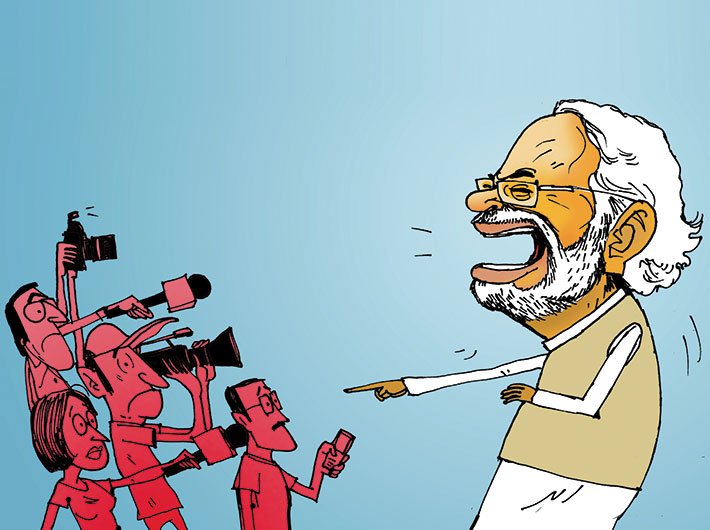There’s so much denial around Narendra Modi in the media that we should be glad his opponents concede he exists in flesh and blood!
It’s been nearly 13 years since Modi took political executive office. Not for a day in these years, till about six months ago, could the so-called national media associate anything good with him. Modi was the devil incarnate, a rabid right-winger who rode to power on the back of one tragedy, the Bhuj earthquake – surprisingly, the media didn’t blame Modi for it – and cemented it with another, the post-Godhra riots.
The national media painted the local, especially the Gujarati, media as either sharing Modi’s idea of India by inclination or by coercion. This assessment was extended even to their Gujarat-based correspondents. Consequently, any reference to Modi’s ability to administer well anything other than the post-Godhra riots was immediately suspect in the eyes of the Delhi know-it-alls.
The Gujarati press did not care. While there was substantial amount of Modi-bhajan, some of them like Gujarat Samachar, the big daddy of Gujarat’s media, could be extremely hostile to Modi, at least sporadically. But the no-good-news-from-Gujarat diktat of the Delhi editors had a deleterious impact on the local correspondents of national newspapers and channels, especially the latter. Realising that their Delhi editors wanted an “ogre angle” to every Gujarat story and unable to invent one all the time, the local bureaus either fell silent or fed the Delhi fat cats what they wanted.
Inevitably, the discourse on Modi began taking shape on grounds ideological rather than on reports from the ground. Ideologists, editors and public figures who wear their liberal leaning on their sleeves teamed up and played every trick in the book to circumscribe the Modi narrative to Godhra. Naturally, a big part of this circumscription exercise was denial…denial of everything Modi.
Denial of Modi the good administrator: we’d prefer a bad administrator with no blood on his hands, thank you!
Denial of Modi the strong and decisive leader: he rules with an iron hand, is a control freak, stamps out opposition, is a dictator, fascist…
Denial of more than a decade of peace: peace has no meaning when an entire community is terrorised, living in fear, in filth…have you ever been to Juhapura?
Denial of Modi’s growth model: oh, Gujarat was a developed state much before his arrival and anyway, Haryana’s growth rate is higher, and do you even know 48% of Gujarat’s children are malnourished?
Denial of Modi the rising national star: India will never accept a communalist, forget India, his own party will not allow him to cross the state border, C’mon LKA, get him!
Denial of Modi the alliance-builder: he’s no Vajpayee, allies will run away, already NDA is just a three-party coalition and, by the way, nobody can get a decisive verdict without the minority vote.
Denial of the Modi wave: where is it? If it is there, it won’t hold, he’s peaked too early, won’t last till the elections… (when it became difficult to deny the obvious).
And, of course, the mother of all denials:
Denial of Modi’s stunning victory: he may have won 282 seats but that’s only because of the stupid first-past-the-post system, he won on just a 31% vote share, that means a whopping 69% of the voters rejected him and his growth model. Whoaaaa! We’ve won!
It is quite possible that Modi went to the Hitler School of Administration while the rest of his political contemporaries, kind souls all, trained at Mother Teresa’s Missionaries of Charity. Or that Sonia Gandhi’s 28.6% mandate in 2009 is worth two times its weight because she is a secular leader. But whatever it is, the Denial-ists are right to the extent that Godhra 2002 made the man. Even Modi’s supporters are not in denial about that, making that the only area where backers and baiters are in total agreement. But thereon, the discourse around him was so thoroughly hijacked by the latter that it was risky to suggest that there might be more to the man than just a “maut ka saudagar”.
The self-certified liberals – and editors seeking their approbation – were unequivocal. Modi was a dangerous anathema to the very idea of India, even if, by their own freshly-minted logic, Nehru’s own idea of India was rejected by a majority of 52% voters as far back as 1957 (372 seats with 47.8% votes). Hence, there was no dearth of saviours of the idea of India.
UR Ananthamurthy became more famous for declaring he would exit the country if Modi became prime minister than for his entire body of Jnanpith work and Ashis Nandy for wanting to exit the world itself before that dark day dawned on India. As I write a day after Modi’s oath-taking, Ananthamurthy is well ensconced in his Bangalore home and, god grant him a long life, Nandy has decided, well, how shall I put this…not to depart! There’s no word on their changed travel plans or revised schedules of departure.
Ananthamurthy and Nandy have not yet offered explanations and the media will not seek any either because the media has its own explanations to give. Why, after demonising Modi for 12 relentless years, have they failed to stop the country from going into his hands? Like the Congress party, the media might be tempted to say “we could not communicate effectively” but logic says that the masses simply rejected the media’s portrayal of Modi.
Of course, the declaration of a Modi victory in this decade-old argument on the basis of an electoral win is questionable. It suffers from the serious limitation of judging everything through the election prism. As senior journalist and author Sopan Joshi says, “This has to do with the terribly unfair and disproportionate attention that goes to the world of electoral politics and governments. It’s a travesty. It’s like reading all the diverse facets of complex country through its share market.” But we have the model we have.
That leads us to the question: why did the public reject the media’s version of Modi? A message fails for two reasons: one, it is too weak to be effective and two, it is inaccurate. Considering the longevity, intensity and amplitude of the attack on Modi, the first can be chucked out the window, so the question of accuracy comes up. Here, there are two levels to the Modi message that we need to study.
Level one was the unstated, but hardcore Hindutva message, amplified not so much by Modi’s own sayings or doings (especially after his 2007 election victory) as by the ferocity of the attack on him from all quarters. The mantle was now his even without staking claim for it because the “other side” pushed him into a corner and kept him there. While the media was not off the mark in questioning the religious undertones of the 2014 Modi campaign, it treaded ever so softly on the contesting ideology of minority welfarism and attendant tokenisms. The result, as Ajay Singh, editor of this magazine, aptly puts it, was this “volcanic eruption of Hindu nationalism”.
Level two was the development messiah message that Modi worked on silently and ceaselessly. Having won the 2007 election against all odds, Modi disconnected with the mainstream media altogether. He invested early and heavily in the internet and social media and built a parallel dialogue directly with the people. With 1.6 crore likes on his Facebook page and 4.4 million followers on Twitter he is a media house in his own merit today. The traditional media had its way as long as it was the only medium of communication between Modi and his audience. Once it was knocked off its pedestal, it did not matter to Modi how much noise the media generated. Just like white noise, it managed only to irritate even those not glued to the screen, say, women voters.
With the traditional media demonising him and his ardent followers deifying him, the debate on Modi was being conducted on two parallel tracks, both taking to myth-making in equal measure. The 2007 election was a good occasion for the media to put Modi’s performance under the scanner. He had just successfully implemented ground-breaking power reforms and was beginning to be noticed for his governance skills. But it was dangerous to suggest such story ideas in Delhi’s newsrooms for fear of being labelled “closet chaddi-walahs”. The atmosphere in many newsrooms was such that even a legitimate pro-Modi story idea had to be prefaced with “I’m no fan of Modi, but….”
That’s why it’s laughable when people say there was no freedom of expression under Modi in Gujarat. There was no freedom of expression in most newsrooms when it came to Modi. I have no direct knowledge of how many negative stories Modi had killed, but having been in many newsrooms, I can vouch for this overhanging fear in newsrooms about being branded pro-Modi. If at all, it was one dictator in Gandhinagar versus countless editor-dictators across the country.
The result of all this was that nobody got close enough to reveal the real Modi to the world. If the debate had neither been at the God-end or the Devil-end and located somewhere in the middle, we could have had a more real assessment of his accomplishments or failures. In the absence of that, the myth grew and so did the man…leaving a huge 12-year knowledge gap in the evolution of Modi the chief minister into Modi the most successful political face of the Hindu nationalist movement, dwarfing peers Vajpayee and Advani.
The media owes it to itself to introspect on how it got the Modi story so wrong. How did a terribly bad guy come to take, almost overnight, the highest office of the land? Has he become good or has one-third of the country (31%) turned devilish? The media needs to account for the 12 missing years of Modi but we won’t see much of that. The best way to deal with a bad memory is to erase it, at least temporarily and that’s what is happening. This snatch from a story amused me over the weekend. Sagarika Ghosh – a diehard Modi baiter – landed up in his ancestral village, Vadnagar. There she discovered Modi’s connection with Mughal Emperor Akbar! Apparently, centuries ago Akbar had invited two female singers from Vadnagar to perform in his durbar….and now Modi, a Vadnagar boy, is the Durbari himself. Wow! Akbar knew Modi was coming! Jahanpanah, tussi great ho!
You get the drift. It’s now time to err on the other side; lavishing so much sugar and syrup on all things Modi that it’s already starting to get a bit nauseating.
(This column appeared in the June 1 to 15, 2014 issue of the magazine)

